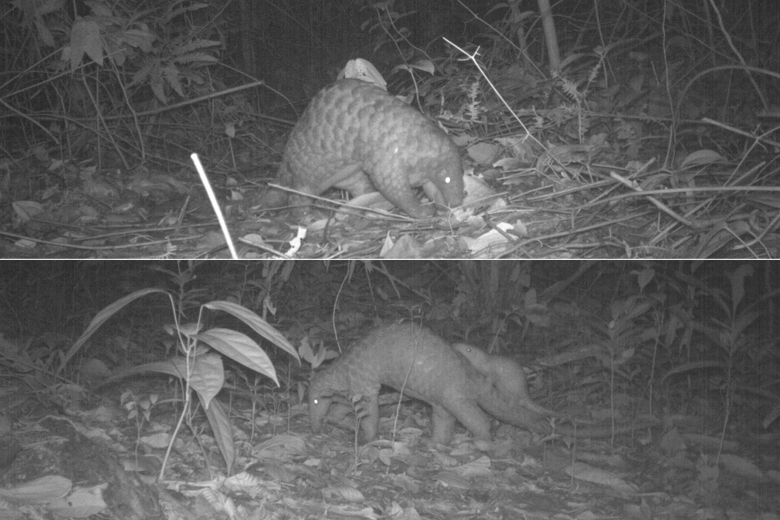Wildlife still present in nature reserve after site investigation works for Cross Island MRT Line, says LTA
Sign up now: Get ST's newsletters delivered to your inbox

(Top) A sunda pangolin spotted near Sime Trail on a camera trap on Dec 12, 2016, before drilling works started nearby for site investigation. (Above) a sunda pangolin mother and juvenile spotted near Sime Trail on a camera trap on Oct 1, 2017, after drilling works nearby for site investigation were completed.
PHOTOS: LAND TRANSPORT AUTHORITY
Derek Wong
Follow topic:
SINGAPORE - Wildlife is still present in parts of the Central Catchment Nature Reserve where drilling for soil samples has taken place, said the Land Transport Authority (LTA) on Friday (June 8).
The drilling was part of the authority's site investigations to study the impact of the Cross Island MRT Line (CRL) running under the reserve.
The LTA found the presence of wildlife in monitoring results from cameras and ground surveys.
Photos captured by camera traps included those of endangered animals such as the sunda pangolin and the lesser mousedeer.
Photos captured by camera traps included those of endangered animals such as the sunda pangolin and the lesser mousedeer.
LTA's director of civil design and land, Dr Goh Kok Hun, said the findings were encouraging and validated the mitigation measures put in place to minimise impact of site investigation works on the flora and fauna in the reserve.
The investigation works, which took place between May 2016 and September last year, involved drilling 16 boreholes to extract soil samples.
They were the first steps in assessing the two CRL alignment options - going directly underneath the nature reserve or skirting it, said LTA.
The line, announced by the Government in 2013, had preliminary plans that showed it going under the reserve, which raised concerns among nature groups here.
LTA consulted the National Parks Board (NParks) and nature groups here over three years before drilling started.
There was a comprehensive suite of mitigation measures, said LTA, such as reducing the number of boreholes required for the works, from 72 to 16.
Other measures included locating the boreholes on existing trails and clearings to minimise the impact on existing flora.
National University of Singapore biology lecturer N. Sivasothi, who has been part of the discussions LTA has had with nature groups, said the suite of measures was "about the highest amount of mitigation demonstrated by any project - maybe anywhere in the world".
He said discussions on the plan were so detailed that they included specifying how an engine pump was to be operated to prevent petrol spillage.
Ms Chloe Tan, spokesman for the Love Our MacRitchie Forest volunteer group, said the presence of animals might not mean there was no impact on the animals and that there is a need to know their abundance and distribution too.
Phase 2 of the study, which assesses the potential environmental impact of future construction - including tunnelling and operations - is ongoing and is expected to be completed later this year, said LTA.
The 50km Cross Island Line will stretch from Changi to Jurong and is set to be completed in 2030.

